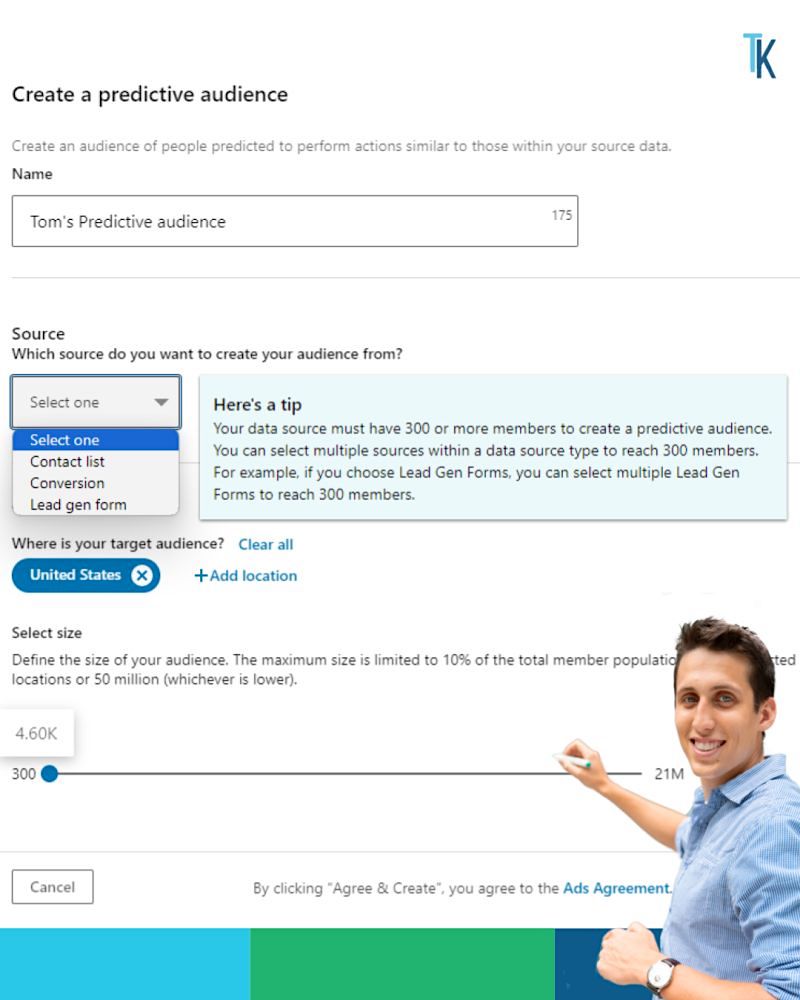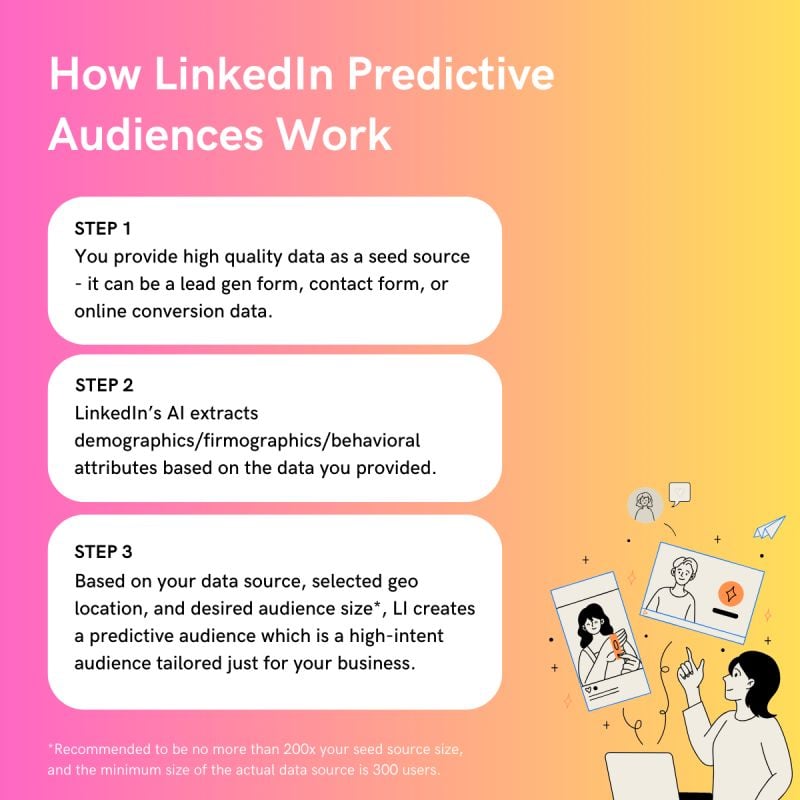LinkedIn, a major platform in the digital advertising landscape, recently announced that they are discontinuing lookalike audiences, a popular targeting option for advertisers. This change will take effect on February 29, 2024.
But what does this mean for marketers who have been using lookalike audiences to reach their target audience? In this post we’ll go over why this shift is happening and what the alternatives to lookalike audiences are.
What Are Lookalike Audiences?
Lookalike audiences are a type of targeting option that allows you to reach new users who are similar to your existing customers or website visitors. This is done by using data about your existing audience, such as demographics, interests and professional background, to identify new users who share similar characteristics.

This tool was particularly useful for B2B marketers due to LinkedIn’s professional context and rich data on users’ job functions, industries and seniority levels. It helps drive brand awareness, lead generation and, ultimately, sales by efficiently reaching potential customers who are likely to be interested in what you’re offering.
LinkedIn lookalike audiences have been effective for several reasons:
- Reach Expansion: They allow businesses to reach beyond their existing network and find new prospects who are likely to be interested in their products or services.
- Increased Relevance: Ads are shown to individuals who are similar to an advertiser’s best customers, making the content more relevant and engaging.
- Efficiency: By targeting users similar to those already interested in your business, you can improve the efficiency of your ad spend.
You might also like: Running Ads on LinkedIn: How to Create Your First Ad Campaign
Why Is LinkedIn Retiring Lookalike Audiences?
LinkedIn has not given a specific reason for retiring lookalike audiences, but there are a few possible explanations.
One possibility is that lookalike audiences are not as effective as they once were, due to changes in the way that LinkedIn collects and uses data. Another reason may be privacy concerns, as this function can be used to target users based on personal data without their explicit consent.
This feature was instrumental in helping advertisers reach new individuals who resembled their existing customers, so now the phasing out of lookalike audiences pushes marketers towards more advanced targeting options.
When LinkedIn’s lookalike audiences are discontinued at the end of February 2024, this will mean that:
- New lookalike audiences can’t be created and existing lookalike audiences can’t be edited.
- Existing lookalike audience data will no longer refresh and a lookalike audience will become a static lookalike audience.
- Active campaigns using lookalike audiences will continue to deliver using the static audience.
You might also like: LinkedIn Ads for Enterprise B2B SaaS: The Only Guide You’ll Need
What Are the Alternatives to Lookalike Audiences?
As a response to the discontinuation of lookalike audiences, LinkedIn has introduced two alternative targeting tools: Predictive Audiences and Audience Expansion. These tools are designed to maintain the efficiency of digital campaigns while leveraging LinkedIn’s rich data capabilities.
Predictive Audiences
Best for: for contact list, conversion, or Lead Gen Form data sources.
This tool uses LinkedIn’s AI to identify users who are likely to convert, such as leads or customers. It’s done by using machine learning to analyze your data and identify patterns that can be used to predict future behavior.
To create a predictive audience, a minimum of 300 individuals in the selected data source is required:

However, there is a limitation of 30 predictive audiences per ad account, and they cannot be shared between accounts. Notably, campaigns using predictive audiences will not have the option to expand their audience reach.
Learn more about Predictive Audiences here.
Audience Expansion
Best for: for Matched Audiences and LinkedIn attribute targeting, such as by skill or interest.
Alternatively, Audience Expansion targets users who share similar characteristics to your existing audience, such as demographics, job titles or companies. This can be a good way to reach new users who may be interested in your products or services.
This tool can be combined with Matched Audience segments to enhance targeting precision. The performance metrics provided will include data from both the initially targeted group and the expanded audience, although this feature is not available for adaptive ad formats or audiences selected based on predicted behaviors.

Learn more about Audience Expansion here.
You might also like: Benefits of LinkedIn Ads: How to Make Your B2B Brand Excel on Social
How to Transition from Lookalike Audiences to New Targeting Options
The retirement of lookalike audiences is a significant change for LinkedIn advertisers. However, if you carefully plan your transition and test new options, you can rest assured that your advertising campaigns will continue to be successful.
The transition away from lookalike audiences entails several implications for current advertising campaigns:
- Transition Period: LinkedIn has provided a 30-day grace period during which existing lookalike audiences will remain accessible before being archived.
- API Changes: The change also affects the use of LinkedIn’s API for creating lookalike audiences through third-party marketing platforms. This discontinuation necessitates a shift in strategy for marketers relying on such integrations.
- Campaign Adjustments: Advertisers using lookalike audiences must shift to either predictive audiences or enable audience expansion to maintain a dynamic targeting approach.

If you have been using lookalike audiences, it is important to start planning your transition to new targeting options now. Here are a few tips to do this:
- Identify your goals: What are you hoping to achieve with your advertising campaigns? Once you know your goals, you can choose the targeting options that are most likely to help you achieve them.
- Start small: Don’t try to switch all your campaigns to new targeting options overnight. Start by testing out a few new options on a small scale, and then gradually scale up as you see results.
- Track your results: It is important to track your results so that you can see which targeting options are performing the best. This will help you to make informed decisions about where to allocate your advertising budget.
- Use a mix of targeting options: Don’t rely on just one targeting option. Use a mix of different options to reach a wider audience.
- Keep your audiences up-to-date: Make sure that your audiences are up-to-date with your latest customer data. This will help you to ensure that you are reaching the right people.
- Be patient: It takes time to test and optimize new targeting options. Be patient and don’t give up if you don’t see results immediately.
By following these tips, you can make a smooth transition from lookalike audiences to new targeting options and continue to reach your target audience on LinkedIn.
You might also like: 24 Essential LinkedIn Hacks for Dynamic Growth in 2024
Last Word on LinkedIn Lookalike Audiences
LinkedIn’s move reflects a broader trend in digital advertising towards more AI-driven and data-centric approaches. This shift is expected to offer better targeting precision and efficiency, aligning with the evolving needs of modern digital marketing.
The sunsetting of LinkedIn’s lookalike audiences represents both a challenge and an opportunity for advertisers. But by embracing Predictive Audiences and Audience Expansion, marketers can leverage LinkedIn’s powerful data analytics and AI capabilities to reach their desired audiences more effectively.
If you’re ready to drive high-quality lead generation for measurable growth, Single Grain’s LinkedIn Ads experts can help!👇
LinkedIn Lookalike Audiences FAQs
-
How do I target matched audience on LinkedIn?
Since LinkedIn has retired Lookalike Audiences, Matched Audiences offer a valuable alternative for reaching specific profiles in your target market. Here’s how to target matched audiences on LinkedIn:
1. Choose your data source:
- Email list: Upload a CSV file containing email addresses of your target audience.
- Website visitors: Install the LinkedIn Insight Tag on your website and create audience segments based on visited pages, lead forms submitted, etc.
- Company account lists: Target contacts at specific companies by uploading a list of company names or domain names.
- CRM integration: Connect your CRM software to LinkedIn to target existing customers or leads.
2. Create your matched audience:
- In LinkedIn Campaign Manager, navigate to the “Audiences” tab.
- Click “Create audience” and select “Matched Audience.”
- Choose your data source and upload your file or connect your CRM.
- Refine your targeting (optional): Filter by job title, industry, or other criteria.
- Save your audience for future use.
3. Target your audience in campaigns:
- When creating a campaign, select “Targeting” and choose “Audience.”
- Include your matched audience alongside other targeting options like demographics, interests, or skills.
- Launch your campaign and monitor its performance.
-
What is the match rate for LinkedIn matched audience?
LinkedIn doesn’t provide a single, universal match rate for Matched Audiences, as it depends heavily on the quality and format of your data. Factors affecting match rate are data quality, data source (website visitors with the LinkedIn Insight Tag tend to have higher match rates than email lists), and data format.
Understanding match rate results:
- <5% match: Indicates less than 300 members matched successfully, suggesting data quality issues or a very specific audience.
- Variable match rate: Ranges can vary depending on factors mentioned above. Aim for higher rates (closer to 100%) for better campaign effectiveness.
-
What is the difference between predictive and lookalike on LinkedIn?
In short, Lookalike finds similar users based on past data while Predictive finds likely users based on future predictions.
Both Predictive and Lookalike audiences on LinkedIn aim to expand your reach beyond a specific audience, but they achieved this in different ways:
Lookalike (discontinued):
- Based on: Existing audience with similar characteristics like demographics, interests, and professional background.
- Goal: Find new users similar to your existing audience.
- Limitation: Relied on past data, potentially missing new potential customers with changing behaviors.
- Replaced by: Predictive Audiences and Audience Expansion.
Predictive:
- Based on: Machine learning analysis of your campaign data (conversions, leads, etc.).
- Goal: Identify users likely to take a specific action (convert, engage, etc.).
- Advantage: Considers future behavior predictions, potentially reaching high-intent users beyond simple lookalikes.
- Limitation: Requires sufficient data for accurate predictions.
-
What is lookalike audience examples?
Remember, LinkedIn no longer offers Lookalike Audiences as of February 29, 2024. Here are some examples of how businesses might have used Lookalike Audiences on LinkedIn:
- Industry-specific example: Financial services company targets new users who share similar characteristics (job titles, income levels, investment interests) with their existing high-value clients.
- Engagement-based example: E-commerce store reaches users with similar browsing and purchase history to customers who bought a specific product line.
- Website traffic example: Travel blog targets individuals who browsed travel destinations and itineraries similar to those booked by past customers.








